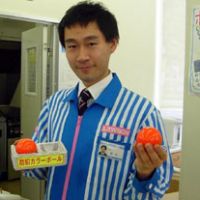Dear Alice, I've spotted pairs of plastic Day-Glo orange baseballs sitting in polystyrene containers behind the counter at banks and convenience stores. My friend reckons they have them in police stations too. Can you please tell us what the heck they are?
Nicholas C., Tokyo
Dear Nicholas,
Those aren't baseballs, despite the resemblance in shape and size, and the fact that some models even have fake stitching to evoke the real thing. The orange orbs you observed are called bohan yo kara boru (anticrime color balls). Basically, they're paint balls — plastic spheres filled with brightly colored liquid pigment. But unlike the fun-and-games variety, these balls are kept on hand in case of a stickup. The idea is to lob one after a robber and mark him to improve the chance of an arrest.
I know what you're thinking: That's fine if the pitcher of the local high school's baseball team happens to be manning the register that night, but can the average convenience-store clerk hit a moving target? I looked into that, and the advice is to aim for the ground near the perp's feet, because the balls shatter on impact and release their contents in a radius as wide as 10 meters. Or fling for the getaway vehicle since a car or motorbike offers a larger target.
But the bigger problem is that most victims can't think well — let alone pitch well — during the stress of a robbery. According to statistics from the National Police Agency, there were 230 late-night store robberies during the first half of 2007. In 197 of those incidents, or 85.7 percent, the store had color balls readied by the register. But in only seven of those cases — a mere 3 percent — did an employee actually throw a ball.
So what's the point?
"Even if the balls aren't actually used, that they are in the store and visible to would-be thieves helps protect the store," Akihiro Suwa, a public-safety officer with the Tokyo Metropolitan Police told me. "That's why we, and police departments around the country, ask banks and store owners to include color balls as part of their crime-prevention efforts."
Kazuo Kimura, senior manager for public relations at convenience-store operator Lawson, agreed that their main value is as a deterrent: "We have introduced color balls in all of our 8,500 stores, and we put signs on them so there's no mistake about what they're there for." When I asked about other anti-crime measures, Kimura said all Lawson stores have emergency alarms and digital security cameras, but declined to go into further detail lest the pages of The Japan Times fall into criminal hands.
Still, arrests do happen thanks to color balls. Just last month, a man held up an agricultural cooperative in Yokohama and made off with a bag of cash. When an employee was able to mark the getaway truck with a color ball, the thief abandoned his vehicle and fled on foot. But the police tracked him down through the truck's registration and arrested him at home. I got this much of an answer for you fairly easily, but what I couldn't find out, and not for lack of trying, was who the heck makes the balls. My normal modus operandi for a story that revolves around a product is to get the manufacturer's name off the merchandise, find a telephone number on the Internet, and call the company for an interview. But this time, that didn't work.
First of all, there's no identifying information on the balls. (I peeked at a pair at the post office.) And no amount of Googling yielded a company name. This was strange in and of itself, but then everyone I asked — even the police — claimed not to know. Had I stumbled onto a state secret? Why would everyone shield a company that makes colored balls? One ball buyer didn't play dumb, but he refused to give up a name or a telephone number. Finally, I convinced him to make a call on my behalf. This got me in touch, if only indirectly, with the company that makes almost all of the color balls sold in Japan.
Through my intermediary, I learned that anticrime color balls were developed about 20 years ago as — I know this sounds weird — an egg replacement. At that time, the nation's highways had a problem with toll evaders, and toll-booth attendants had taken to throwing raw eggs at vehicles that charged through without paying their tolls. While the police appreciated this effort to mark nonpayers, they felt it was inappropriate to use food for the purpose. So someone came up with pigment-filled balls as an alternative. An improvement, really, since eggs can be washed off but the paint in color balls leaves a permanent stain. The use of color balls spread from toll booths to banks, and, by the late '80s, convenience stores started to introduce them as well. Most police stations and and police boxes keep them on hand, while newer users include hotels, gas stations and even the Japanese Marine Self-Defense Forces.
Color balls have a limited shelf-life (the pigment hardens after a few years), so including existing users who buy replacements, the market is an estimated 100,000 balls a year. The balls seem to be used only in Japan. But why all the secrecy? The best answer I got was that there's no need to market the product because legitimate users get purchasing information from the police. And the manufacturers would just as soon keep a low profile among the public at large. While it is possible for individuals to buy balls from security-goods wholesalers, so far there hasn't been much of a problem of misuse. This is in stark contrast to the United States, where vandalism using paint-ball guns has become a major headache for police and property owners.
More from the So, What the Heck Is That?



